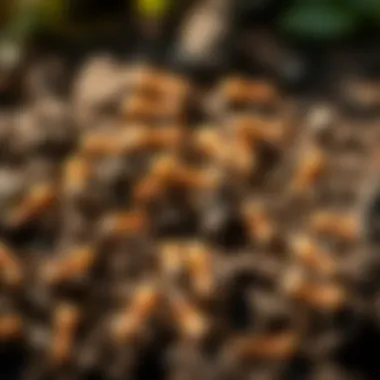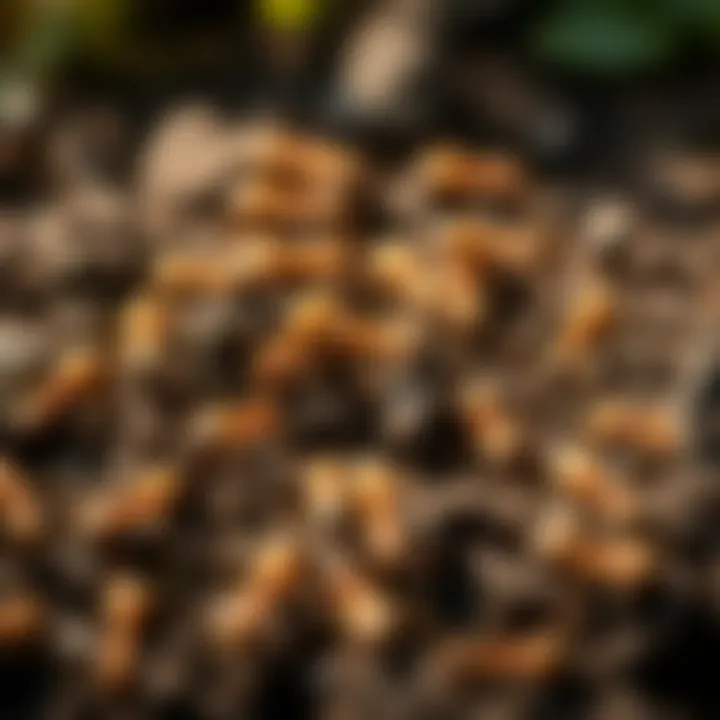Effective Strategies for Termite and Ant Control


Intro
Managing pests like termites and ants can feel like an uphill battle for homeowners. The stakes are high; not only do infestations pose potential structural damage and health risks, but they also intrude upon the sanctity of our living spaces. Understanding these pests starts with identifying them properly. Once you know what you’re dealing with, you can develop effective strategies to keep your home secure and comfortable.
In this guide, we will dive deep into various aspects of termite and ant management. From identifying these stubborn pests to implementing prevention strategies and exploring treatment options, you’ll be equipped with the knowledge needed to circumvent infestations. Let’s kick things off with the first essential step: Pest Identification.
Pest Identification
Detailed descriptions of common pests
Termites and ants may look similar at a cursory glance, but they belong to different families and exhibit distinct behaviors.
- Termites: Typically creamy white or light brown, they're known for their strong, straight antennae. Termites are social insects and thrive in colonies, often representing a considerable threat to wooden structures in your home.
- Ants: They vary widely in color and size, ranging from tiny black ants to larger red or brown species. Ants are also social creatures, living in colonies, but their appearance strays from a uniform look, with their segmented bodies making them easier to distinguish from termites.
Recognizing these differences can be incredibly helpful in determining the best course of action.
Signs and symptoms of infestations
Ignoring the early signs of an infestation can lead to larger issues. Here are some critical indicators to keep an eye out for:
- Termites: Look for mud tubes, which they create to protect themselves while traveling between their nests and feeding grounds. Additionally, you might notice frass—tiny wood-colored pellets—near wooden structures that indicate they are munching away.
- Ants: If you see ant trails leading to food sources or spotting nests near your home, it’s a clear sign of ant activity. You'll often find them around kitchen areas, foraging relentlessly.
"Being on the lookout for signs of infestation can save you from headaches down the line. Don’t ignore those tiny signs!"
Prevention Strategies
Home maintenance tips for pest prevention
Maintaining your home is the cornerstone of prevention. Consider implementing these practices:
- Seal cracks and gaps: Ensure any cracks in walls, foundations, or decking are sealed properly. This removes potential entry points for pests.
- Proper ventilation: Keep areas like attics and basements well-ventilated to avoid excess moisture that attracts termites.
- Regular inspections: Conduct routine checks around your home and property to identify potential infestations early.
Natural deterrents and barriers
If you're on the fence about using chemical solutions, there are natural alternatives you can explore:
- Essential oils: Many essential oils, like peppermint and tea tree, are known to deter ants. Spray diluted mixtures around entry points.
- Diatomaceous earth: This natural powder can trap and dehydrate pests. Sprinkle it in areas where you suspect termite or ant activity.
These approaches can serve as effective shields to deter infestations without resorting to harsh chemicals.
Treatment Options
Overview of chemical vs. natural treatments
When it comes to eradication, two primary pathways emerge: chemical and natural treatments.
- Chemical Treatments: These often offer immediate results and are potent against large infestations. Look for products specifically designed for termites and ants; they typically come in convenient applications like sprays or baits.
- Natural Treatments: Though they may take longer to show results, they are generally safer for the environment and household pets. Options include vinegar solutions, boric acid, and essential oil blends.
Step-by-step guides for DIY treatments
Here’s a basic sequence for tackling ant and termite issues with DIY methods:
- Preparation: Clear the area of clutter and debris.
- Identify the source: Use the aforementioned identification tips to find nests or trails.
- Apply treatment: Based on your chosen method (chemical/natural), apply it as directed.
- Monitor: Keep an eye on the area for any signs of persistent activity.
- Repeat if necessary: Depending on the severity, recurring treatments might be needed.
For more detailed tips, you could check resources like Wikipedia or EPA's pest control guidelines.
If you have concerns specific to your situation, consulting professionals can provide tailored solutions. Pest control doesn’t have to be a daunting task—staying informed is your best defense.
Understanding Termites and Ants
Understanding termites and ants is crucial for homeowners and professionals alike. Infestations of these pests often escalate unnoticed until significant damage occurs. Knowledge about their life cycles, habitats, and behaviors allows for appropriate preventive and treatment strategies. This section provides the groundwork for successfully managing infestations, enabling informed decisions and proactive measures.
Life Cycles and Habitats
Termites and ants have complex life cycles, behaviorally distinct across species. Generally, they go through several stages: egg, larva, pupa, and adult.
- Termites: Their colonies revolve around a caste system, where workers, soldiers, and reproductive individuals exist in harmony. Typically, subterranean termites build their colonies underground, while drywood termites nest within the wood they consume. Due to moisture and food source fluctuations, termites often relocate.
- Ants: Similar to termites, ants also display numerous castes. They create nests within soil, wood, or even inside walls of houses, depending on the species. For instance, carpenter ants burrow into wood structures, while pharaoh ants often infest places like hospitals or schools, making them adaptable to various environments.
Understanding their life cycles helps homeowners to pinpoint the right preventive measures and treatments. Spotting a swarm of reproductive ants or termites may signal a potential infestation in close quarters.
Common Types and Identification


Identifying termite and ant species is imperative for effective eradication. Here are several common types:
- Termites:
- Ants:
- Subterranean Termites: Recognizable by their mud tubes leading to wood structures. They are notorious for their appetite for cellulose found in wood.
- Drywood Termites: They create galleries in dry, uninfested wood without needing moisture from the soil.
- Carpenter Ants: Large and often black, they leave behind small sawdust piles when they excavate wood.
- Fire Ants: Known for their painful stings, they form large mounds in sunny locations.
Proper identification can save you time and money. Utilizing visual guides or checking resources like Wikipedia can provide additional support.
Behavioral Patterns
Understanding the behavior of termites and ants can effectively lead to eradication. For instance:
- Termites are social insects that communicate through pheromones. This trait aids in foraging and colony construction. When seeking food, they leave behind scent trails, making it easier for others to follow.
- Ants also follow pheromone trails and display a “foraging pattern” that leads them back to their nests. Their aggressive behavior, particularly in species like fire ants, can rapidly escalate when they perceive threats to their colony.
This behavior impacts how we approach eliminating these pests. Knowing their movements allows homeowners to strategize traps and treatments effectively.
In summary, gathering insight into the life cycles, identification methods, and behavioral patterns of termites and ants sets the foundation for this guide. Proper understanding allows for timely intervention, which is crucial in maintaining a pest-free environment.
Signs of Infestation
Detecting the signs of infestation is crucial for homeowners. Recognizing these indicators early can mean the difference between a minor nuisance and a full-blown infestation. Termites and ants can cause irreversible damage to your property, not to mention the stress and financial strain that comes with dealing with such issues. Being attuned to the subtleties in your environment will empower you to make informed decisions and take prompt action.
Visible Damage Indications
When inspecting your home for pest activity, visible damage is perhaps the most alarming sign. Look out for unusual marks or holes around wooden structures. Termites can eat through wood, leaving only a thin layer behind. This can present as blisters on surfaces or noticeably weakened structures.
Common signs include:
- Hollowed-out wood: Gently tapping can reveal a hollow sound, a sure sign that termites have made a meal out of your wood.
- Small holes: Surface holes could indicate that ants are tunneling, particularly carpenter ants, which can also damage wood.
- Frass: This is a fancy term for pest droppings. For termites, this looks like small wooden pellets, often found beneath infested wood.
Understanding and identifying these signs can help you act swiftly before the damages become significant and costlier.
Galleries and Trails
Galleries and trails serve as clear maps of pest activity. Termites carve out intricate tunnels within wood known as galleries, which can sometimes be a livin’ hell for your home’s structural integrity. Ants, too, have their pathways. You might spot mud tubes on walls or foundations where termites travel.
- Termite galleries: These can be found within beams, furniture, or any wooden implants in your home. If you look closely on the surface and notice unexplained grooves, you might have an infestation.
- Ant trails: These little critters often travel in a single line. If you notice them scuttling back and forth along the same path, chances are they are heading to a food source or returning to their nest. Ants will also leave scent trails for their buddies, making them easy to follow and trace back to their home.
Both galleries and trails are indicative of an underlying problem and should not be ignored. The sooner you can pinpoint their presence, the better.
Sound Indicators
Believe it or not, you can also use your ears when scouting for pests. Sounds can be an unexpected but telling sign of termites at work. You might hear a soft clicking noise which is often produced by worker termites when they communicate or when they are munching away.
- Clicking Sounds: When the noises are intermittent and rhythmic, it’s likely that you have termites munching on your wood. Pay attention; if the sounds increase, you’ve got a problem on your hands.
- Rustling Sounds: For ants, rustling noises may occur when they’re actively working through their nests, especially if the nest is within walls or furniture.
Being attentive to these auditory cues can help catch an infestation early on, saving you time and unnecessary headaches. The key takeaway? Don’t dismiss sounds as mere coincidences; they can serve as a valuable early warning system.
"The best defense against a pest problem is timely recognition of the signs that indicate an impending invasion."
By maintaining vigilance and staying observant to the signs of infestation, you create a proactive fortification against pest activities in your home.
Preventing Termite and Ant Infestations
Preventing infestations of termites and ants is crucial, not only to protect your home but also to maintain peace of mind. These pests are often silent invaders, causing extensive damage before their presence is even detected. By taking proactive measures, homeowners can significantly reduce the risk of infestations, ultimately saving both time and money in the long run. Prevention is indeed better than cure, as they say, and understanding what steps to take can make all the difference in keeping these pesky critters at bay.
Structural Modifications
Structural modifications refer to the physical changes made to your property to deter termites and ants. Enhancing the integrity of your home’s structure is not merely about aesthetics; it’s a concrete strategy in pest prevention. Here are some effective modifications:
- Remove Wood-to-Soil Contact: Make sure wooden elements, like decks and porches, do not directly touch the soil. This makes it harder for termites to access these materials.
- Install Metal Shields: Consider using metal flashing around the perimeter of your foundation. This acts as a barrier, making it difficult for termites to enter the structure.
- Seal Cracks and Crevices: Any gaps in walls, foundations, or around utility lines should be sealed properly. Ants especially are known for their ability to squeeze through tiny openings.
"A stitch in time saves nine." This is never truer than when it comes to pest prevention. Addressing structural vulnerabilities promptly can spare you from bigger headaches later.
Environmental Improvements
Creating an environment that is less conducive to pest habitation is another key strategy in preventing termite and ant infestations. Here are a few environmental enhancements to consider:
- Maintain Landscaping: Keep shrubs and trees trimmed and away from the house. Vegetation that touches your home provides a bridge for pests to reach your structure.
- Manage Moisture: Termites, in particular, are drawn to moisture. Fixing leaks, ensuring good drainage, and utilizing dehumidifiers in damp areas can lower the risk of attracting these pests.
- Proper Drainage: Ensure that water drains away from your foundation. Standing water can create a haven for many pests, making an attractive home for termites and carpenter ants.
By making these structural and environmental changes, you not only bolster your defenses against termites and ants but also create a more resilient living space. Such preemptive strategies cater to the needs of not just your home but the well-being of your household as well. Keeping an eye on these factors can lead to a significant decrease in pest problems, ultimately allowing you to enjoy life in a pest-free environment.


DIY Methods for Treatment
When it comes to tackling termite and ant infestations, many homeowners often seek cost-effective and accessible methods. DIY methods for treatment can serve as an excellent first line of defense in dealing with these pests. By employing simple techniques, individuals can address infestations swiftly without necessarily resorting to professional intervention at the outset. Additionally, these approaches can be safer, as they often utilize natural ingredients, reducing the exposure to harsh chemicals.
Using DIY methods does have specific benefits. One key advantage is the sense of empowerment that comes from controlling pests in your own home. Not only does this provide immediate action against unwanted guests, but it often helps in educating oneself about the nature of these pests. Moreover, taking a proactive stance by employing DIY techniques can allow for more thorough inspection and understanding of how these insects operate within your space.
However, it is important to consider certain factors along the way. Not every method works universally. The effectiveness of a solution can depend on the specifics of the infestation or the environmental conditions. It’s also wise to approach these solutions with a mindset of continuous monitoring. DIY methods shouldn't be viewed as a silver bullet, but rather as part of a broader pest management strategy.
Natural Remedies
Natural remedies have gained popularity due to their eco-friendly and non-toxic properties. For those keen on avoiding chemical solutions, these alternatives offer effective means to deter termites and ants.
- Boric Acid: A formidable deterrent that disrupts the digestive system of both ants and termites. Create a mixture with sugar to attract ants, which then carry the bait back to their colony. This method can significantly reduce the population over time.
- Diatomaceous Earth (DE): A fine powder composed of fossilized algae, DE is effective by drying out insects. Sprinkling it in areas where you've spotted activity will halt their progress. Just take care to reapply after rainfall if outdoors, as moisture diminishes its effectiveness.
- Essential Oils: Certain oils like peppermint, tea tree, and clove oil have shown effectiveness in repelling these pests. Mix a combination of these oils with water in a spray bottle, and apply in areas of concern. The strong scent can break the pest's concentration, driving them away.
These natural remedies are relatively easy to implement, making them suitable for homeowners. Still, it's crucial to understand the right dosages and methods of application.
Homemade Traps and Baits
Creating your own traps and baits can be an ingenious approach to curb insect activity. Not only do they tend to be inexpensive to assemble, but they can also be tailored to local pest varieties.
- Ant Bait Stations:
- Cardboard Trap for Termites:
- Vinegar and Baking Soda Trap:
- Combine equal parts of boric acid and sugar with a sufficient amount of water to form a syrup.
- Soak pieces of cotton into the syrup and place them in shallow containers. Ants will be lured in, take the bait back to their colony, all while keeping your surroundings clean and organized.
- Lay a few pieces of damp cardboard in infested areas. As termites are drawn to the cellulose in the cardboard, they’ll congregate there. Once you see them, you can easily remove the traps and dispose of them safely.
- A mix of vinegar and baking soda creates a volcano effect. Use a few drops in an opening to deter ants. While they won’t be eliminated instantly, it can disrupt their trails and prevent further access.
Utilizing homemade traps not only fights existing infestations but can also act as preventative measures for the future. Make sure to regularly revisit and replenish them as needed for the best effect. Always monitor the conditions and adjust your affairs based on the evolving presence of pests.
Key Takeaway: DIY methods, while effective, require careful consideration of the environment and continuous monitoring for long-term success. It's essential to recognize when to escalate from DIY methods to professional interventions to ensure a pest-free home.
Chemical Treatment Options
Chemical treatments play a critical role in the fight against termite and ant infestations. While natural methods can be effective, there are moments when a more robust approach is necessary. Pests like termites and certain species of ants can not only damage the structure of a home but also pose significant health risks. The appropriate use of insecticides and other chemical solutions can provide immediate results when dealing with these destructive pests. This section outlines the key aspects of chemical treatments, including usage guidelines and professional-grade solutions, to ensure homeowners have a comprehensive understanding of the options available.
Insecticides and Their Usage
Insecticides are commercial products formulated to kill or repel insects. When it comes to termites and ants, selecting the right insecticide is crucial. Here are some important considerations for their use:
- Active Ingredients: Familiarize yourself with common active ingredients such as bifenthrin, imidacloprid, and fipronil. Each of these has specific modes of action; bifenthrin works on contact, while imidacloprid disrupts the insect’s nervous system over time.
- Application Methods: Insecticides can be applied in various ways, including sprays, granular forms, or bait stations. Baiting is often effective for ant control since ants carry the bait back to their colony, impacting the broader population.
- Safety Precautions: Always follow manufacturer instructions carefully. It's important for homeowners to wear protective gear during application, like gloves and masks. Well-ventilated spaces are essential to avoid inhalation of harmful fumes.
- Timing: Apply insecticides during the peak activity seasons of these pests, usually spring and summer. This ensures that treatments are most effective when infestations are likely to be at their highest.
"Proper timing and application of insecticides can be the difference between a quick fix and a lingering problem".
By adhering to these guidelines, homeowners can effectively eliminate pests while minimizing risks to both themselves and the environment.
Professional-grade Solutions
When faced with severe infestations, professional-grade solutions might be the best course of action. These products usually contain higher concentrations of active ingredients and are designed for use by licensed pest control specialists.
- Boric Acid: Often employed for termite control, boric acid is a potent ingredient both for treatment and prevention. It disrupts the digestive system of insects and is less harmful to pets and humans when used correctly.
- Fumigation: For extensive termite problems, fumigation may be necessary. This entails covering the entire structure with a tent and releasing a gas that penetrates all areas to eliminate pests without leaving behind residues.
- Soil Treatments: Professional services may recommend soil treatments around the perimeter of homes. This acts as a barrier to deter subterranean termites from entering your space.
- Long-term Solutions: Establishing a long-term pest management plan with a professional service will provide continued protection. This often includes not only chemical treatments but also regular inspections and environmental modifications.
Involving professionals not only brings advanced treatments to the table but also ensures that the work is done safely and efficiently.
For further reading on pest control and chemical treatments, consider resources like CDC and EPA regarding safety and environmental considerations.
Professional Pest Control Services
When it comes to dealing with persistent pest problems, knowing when to call in the pros can make a world of difference. Professional pest control services provide specialized expertise and resources that go beyond the standard DIY methods. They have a keen understanding of insect behaviors and the most effective treatments tailored for specific infestations.
Utilizing experts can not only save you time and energy but can also protect your home in the long run, as their methods often prevent further infestations. With advanced techniques and equipment, their thorough approach ensures that the problem is addressed from multiple angles. Moreover, these services often come with warranties or guarantees, giving homeowners peace of mind knowing that they have assistance even after the treatment.
"Using a professional pest control service can be likened to having a trusty insurance policy against unwanted infestations."
Evaluating Service Providers
Choosing the right pest control service is akin to picking a reliable mechanic for your car. It’s essential to do your homework. Here are some pivotal points to consider when evaluating potential providers:
- Experience and Expertise: Always inquire about their longevity in the field. Companies that have been around the block usually have encountered a variety of infestations and have honed their approaches over time.
- Certifications and Licenses: Ensure the pest controllers are certified and licensed according to state regulations. This not only indicates professionalism but also ensures they follow safety protocols.
- Reputation: Dig into reviews and customer testimonials. Platforms like Google Reviews, Yelp, and even Facebook can provide insights into others’ experiences. A service with a solid reputation is often a reliable choice.
- Treatment Methods: Ask about the types of products used. Preferably, the methods should be a mix of effective chemical solutions and natural alternatives, acknowledging the increasing trend towards environmentally-friendly practices.
- Free Estimates: A trustworthy pest control service usually offers free estimates. They should thoroughly inspect your property and identify the issue before providing treatment options.
By doing proper research and comparing multiple providers, homeowners can prioritize quality, reliability, and affordability in their choice.


Treatment Plans and Costs
Understanding the cost associated with pest control treatments is pivotal for budgeting and expectations. Here’s a breakdown of what to look for:
- Initial Inspection Fees: Many service providers start with an initial inspection, which might incur a fee. This is critical, as it helps to identify the specific type of pests and their scale of infestation.
- Treatment Costs: Depending on the infestation's severity and the type of treatment plan, costs can vary greatly. Generally, treatments can range from minor services starting around $100 to comprehensive plans costing several hundred dollars.
- Follow-up Services: Some plans include follow-up services or monitoring to ensure that the pests do not return. Understand whether these services are part of the initial package or if they incur additional costs.
- Customization: Asking if they're flexible in customizing a plan to fit your specific needs can be vital. Every home is different, and a one-size-fits-all approach may not yield effective results.
- Warranty and Guarantees: Good pest control services usually offer some form of warranty or guarantee. It gives homeowners confidence that if the problem persists, they can have it redressed at no further cost.
Understanding these facets of treatment plans and costs helps homeowners make more educated decisions and ensures they are not blindsided by unexpected expenses. For more information on managing pest control costs, various governmental and educational websites provide useful resources: EPA and CDC.
Ongoing Maintenance Strategies
Having a consistent approach to managing pests like termites and ants is essential for safeguarding your home. This section focuses on Ongoing Maintenance Strategies, detailing how regular care can substantially decrease the likelihood of infestations. It's not enough to just react when pests show up; a proactive strategy is your best defense against these relentless invaders.
Regular Inspections
Regular inspections act as the frontline defense in pest management. An inspection should be seen as akin to a check-up at the doctor’s office - preventive and necessary. You don't need to be an expert in entomology to carry out these inspections; just a keen eye and the will to act upon your findings. Schedule these checks every few months, especially during warmer seasons when insects are most active. It's valuable to focus on areas often overlooked:
- Basements and crawl spaces: These dark, damp areas are breeding grounds for termites. Check for mud tubes, droppings, or any sign of deteriorating wood.
- Attics: Look for any signs of ant trails or nests.
- Around the foundation: Inspect whether soil is piled against the house's wooden parts, providing easy access for hungry termites.
During an inspection, take notes on conditions that may foster infestations, such as moisture problems and wood to ground contact. Right here, the action plan kicks in; if you uncover evidence of pests, you can intervene swiftly rather than wait for a minor issue to snowball into a full-blown infestation.
Seasonal Precautions
As seasons change, so does the behavior of pests. Keeping tabs on these cyclic changes and adapting your methods is key. Implementing seasonal precautions can be an effective way to keep your home protected year-round.
- Spring: This is when many pests start ramping up their activity. As the air warms, consider applying a preventive treatment around your home's perimeter. Fortifying it with insect repellents or barrier treatments can prevent ants and termites from making themselves at home.
- Summer: Keep your vegetation trimmed away from your home. Ants love to use trees and shrubs as highways into your property. Be vigilant about checking for ant trails and nests forming in the soil.
- Autumn: As the weather cools, prepare for pests seeking shelter. Seal any cracks or openings around doors and windows. It’s an opportune moment to inspect your attic and basement once again, looking for signs of unwelcome visitors and adding extra insulation to deter them.
- Winter: During this time, conduct a final check of your defenses. Be sure your outdoor lights are working, as these can attract pests. If your home isn’t being utilized as much, consider putting traps in strategic locations in case of lurking pests.
Preventative maintenance is not merely a measure; it is the cornerstone of an effective pest control strategy.
In summary, ongoing maintenance strategies through regular inspections and seasonal precautions can save you a lot of heartache and financial strain in the long run. It's about being one step ahead, ensuring your sanctuary remains a pest-free environment.
Debunking Common Myths
Understanding and addressing the myths surrounding termites and ants is a crucial part of any effective pest control strategy. Many homeowners, driven by widespread misconceptions, may mistakenly believe that these pests only thrive in certain conditions or that they can easily be dealt with using simple home remedies. Addressing these preconceptions not only empowers individuals with accurate knowledge but also enhances their ability to implement effective management strategies.
By dissecting the commonly held beliefs about these pests, homeowners can make informed decisions, ensuring that they don’t fall prey to ineffective solutions or unnecessary panic. Ignoring these myths can lead to prolonged infestations, increased damage, and ultimately, costly repairs.
Myths Surrounding Termites
One prevalent myth about termites is that they exclusively infest decaying or rotting wood. While it’s true that termites favor wood, they aren’t solely limited to the damaged kind. They can just as easily munch through sound lumber, which makes detecting an infestation all the more challenging. These pests are notorious for feeding on the cellulose found in wood, paper, and even some types of plant material. This means that homeowners should maintain vigilance everywhere in their homes, especially where moisture and wood meet.
Another common misconception is that termite damage is purely an aesthetic issue. This is far from the truth. Termites can seriously compromise the structural integrity of a home. Ignoring the potential for hidden damage can have grave consequences; it’s not just about peeling paint or warped woodwork.
While many may believe their home is safe due to a lack of visible signs, homeowners should remain proactive and consider regular inspections.
"A stitch in time saves nine." This proverb underlines the importance of early detection.
Some believe that termites can be completely eliminated with DIY methods. Many householders trust that common remedies or traps will suffice. Unfortunately, such methods might only suppress a problem without resolving it. Professional treatments are usually necessary to fully eradicate these pests, particularly in cases of severe infestation.
Misconceptions About Ants
When it comes to ants, numerous misconceptions abound. For instance, many individuals think that if they see a few ants walking about, there’s no cause for concern. This could not be further from the reality. Ants often follow trails to food sources unseen. Where there’s a handful of ants spotted, there could be an extensive network of them hidden away. Ignoring signs from the initial scouts can lead to larger colonies moving in and making themselves at home.
Far too often, people assume that all types of ants are harmless. However, some species, such as carpenter ants, cause serious structural damage. Just like termites, these ants can turn your beautiful home into a potential hazard. Homeowners must be aware of the specific types of ants and their behaviors to effectively manage infestations.
Lastly, there's a belief that all ants can be dealt with using over-the-counter sprays or household chemicals. While these products provide temporary relief, they often fail to address the root of the problem—the colony. Many times, effective ant control requires a multi-faceted approach that includes baits and professional treatment plans.
In summary, debunking myths surrounding termites and ants is vital. Armed with accurate knowledge, homeowners can avoid pitfalls and take proactive steps. Ignoring labeling these pests often leads to unintended consequences, turning a minor concern into a full-blown infestation.
The Impact of Climate Change
As the relentless march of climate change continues to reshape our planet, its effects ripple through ecosystems, affecting myriad life forms, including the very pests many homeowners dread—termites and ants. Understanding how climate change impacts these pests is not merely an academic exercise; it has real implications for pest management strategies. The rising global temperatures and shifting weather patterns can lead to increased insect activities, exacerbating existing infestations and potentially leading to new ones.
Changes in Insect Activity
One of the most notable consequences of climate change is the alteration in insect behavior and life cycles. This shift can manifest in several ways:
- Extended Lifecycles: Warmer temperatures can accelerate the life cycle of insects. Termites, for example, may breed more frequently and develop faster in warmer environments. As a result, what may have been a manageable infestation can quickly spiral out of control.
- Geographic Range Expansion: Insects that traditionally thrived in warm climates are finding new habitats further north. This means that areas once insulated from termite and ant problems may now find themselves in the crosshairs of these pests. For instance, ants like the Argentine ant are notorious for their ability to spread into new territories, particularly in warming regions.
- Increased Seasonal Activity: With milder winters, ants and termites can remain active for longer periods throughout the year. This means that infestations can begin earlier in the season and persist longer into the fall. Homeowners may find that their pest control measures require new timing and approaches to be effective.
"Changing climate is not just a background issue; it's a front-line factor in pest management strategy."
- Food and Resource Availability: Shifts in the availability of resources like wood and moisture can also influence where and how insects thrive. Dry conditions might drive termites to seek shelter in more humid environments, often leading them to homes where they can cause significant damage.
Given these changes, it’s critical for homeowners to adjust their pest management strategies. Understanding these shifts allows for better preparation and more effective responses. Homeowners should watch for signs of higher ant or termite activity and recalibrate their prevention measures accordingly.
In light of these complexities, it would benefit homeowners to remain informed and vigilant. Regular inspections and environmentally conscious practices can help mitigate risks associated with these pests, ensuring fewer headaches down the line.
For deeper insights, consider exploring resources like National Pest Management Association, which offers guidelines and recommendations tailored to changing pest dynamics, or checking articles on Wikipedia that provide a broader understanding of climate impacts.
Knowing how climate change influences insect populations empowers homeowners and helps frame effective pest control strategies in a rapidly changing world.



